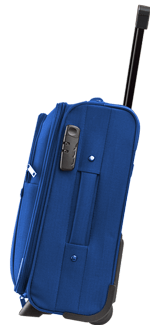How To Clean A Passy Muir Valve
In This Section
Tracheostomy and a Passy-Muir Valve
The Passy-Muir speaking valve is commonly used to assistance patients speak more ordinarily. This one-mode valve attaches to the outside opening of the tracheostomy tube and allows air to laissez passer into the tracheostomy, but not out through it. The valve opens when the patient breathes in. When the patient breathes out, the valve closes and air flows around the tracheostomy tube, upwards through the vocal cords allowing sounds to be made. The patient breathes out through the mouth and nose instead of the tracheostomy.
Some patients may immediately accommodate to breathing with the valve in identify. Others may need to gradually increase the time the valve is worn. Breathing out with the valve (effectually the tracheostomy tube) is harder work than breathing out through the tracheostomy tube. Patients may need to build upwards the forcefulness and ability to apply the valve, but most children will be able to apply the speaking valve all 24-hour interval afterwards a period of adjustment.
How to apply the Passy-Muir Speaking Valve:
- Suction the tracheostomy tube as needed earlier placing the valve. Information technology may not exist possible to use the valve if the patient has a lot of secretions or very thick secretions.
- If the tracheostomy tube has a cuff, deflate it (remove the air from it) before placing the valve. Suction the patient's mouth and olfactory organ as needed before deflating the gage so that secretions exercise not trickle into the trachea (windpipe) and bronchi.
- Adhere the valve to the peak of the tracheostomy tube with a twisting movement to the right (clockwise) approximately ¼ plow. This will prevent it from popping off with coughing.
- To remove the valve, twist off to the left (counter clockwise).
Special Considerations:
- Humidity tin exist used with the valve in place.
- Oxygen can exist given with the valve in place.
- Remove the valve during aerosol treatments. If it is left on, remove it and rinse it to remove any medications that could cause the valve to stick or not piece of work well.
Intendance of the Valve:
- Make clean the valve daily with mild soapy water. (Ivory is suggested.)
- Rinse thoroughly with cool to warm water. Practice non use hot water equally it may damage the valve.
- Allow the valve air dry out completely before using information technology over again.
- Do not use a brush, vinegar, peroxide, bleach or alcohol on the valve.
- Supersede the valve when information technology becomes viscous, noisy or vibrates.
Safety Precautions:
- Patients must not utilize the valve while sleeping.
- The valve should only be used under direct supervision of caregivers who know how it works and how to correctly apply it.
- Remove the valve immediately if the patient has difficulty breathing. Suction and/or change the tracheostomy tube if needed.
- The unabridged manufacturer's pedagogy booklet must exist read prior to using the Passy-Muir Valve.
- The valve must not exist used on tracheas that have the cuff inflated.
Ventilator Users
For some patients, a tracheostomy tube alone may not be enough. The tube may need to be connected to a breathing machine (ventilator) that provides a mixture of gases for life support. Patients on ventilators can speak as long as the tracheostomy tube allows flow through the larynx and vocal cords. Even so, the spoken language patterns of ventilator users present particular issues.
Because of the pattern of the ventilator, speech occurs during the expiratory cycle of the ventilator. Then there is a long silence until the next cycle of the ventilator. During this silence, the patient may lose his or her turn to talk as conversation partners fill the silence with their ain speech communication. Listeners may likewise find it hard to follow the patient's spoken language because the normal rhythm of conversational give-and-take is disrupted.
Spoken phrases may have sudden bursts of loudness, reduced loudness at the end of phrases, and changes in vocalisation quality because pressure in the trachea from the ventilator gases is not equally stable as in typical speech production. Recent research has indicated that the speech of patients on ventilators may be improved past making simple adjustments to ventilator settings, specially if no other bug exist as well breathing insufficiency. At that place is as well at least ane speaking valve bachelor that can be used with a ventilator.
Speech-Language Pathologist and the Rehabilition Team
The multiple and interconnected decisions that demand to be made for patients with tracheostomies or ventilators cannot be made past one professional. Physicians, nurses, respiratory therapists, dietitians, speech-language pathologists, and others must all work together to cull the options that all-time meet the patient'south total health needs. The speech-linguistic communication pathologist assesses the patient's cognitive and linguistic communication abilities to decide communication potential, evaluates oral-motor and swallowing functions, and assesses the patient'southward ability to produce voice in different situations that may include using a speaking valve. Whatever fashion of communication is recommended for the patient in the context of his or her other needs, the spoken communication-language pathologist plays a central function in ensuring that patients and caretakers know how maximum advice tin can be achieved. Speech-language pathologists also care for problems of swallowing when indicated.
Make an extra endeavor to talk with the patient, even if he/she cannot vocalize. If the patient is not able to vocalize, plan for culling methods of communication. Alternative methods include sign language, motion-picture show cards, and communication boards.
Tracheostomy Questions? Email tracheostomysupport@jhmi.edu
Source: https://www.hopkinsmedicine.org/tracheostomy/living/passey-muir_valve.html
Posted by: trippcopievere.blogspot.com



0 Response to "How To Clean A Passy Muir Valve"
Post a Comment